Our first and only wild Giant Panda in Foping Nature Reserve!
Panda Tracking Expedition to Foping Reserve, Qinling Mountains
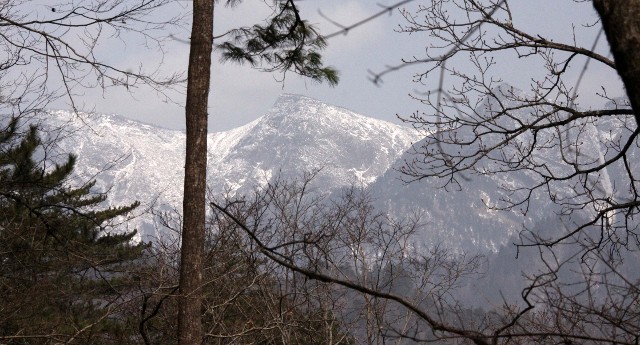
Here are some more images of our expedition to Foping Nature Reserve:
Wild Giant Panda Images of Foping
Birds of Foping
Other Critters of Foping
Landscapes & People of Foping
Pandas of Ya'an Panda Reserve
During our spring break, we embarked on an adventure of a lifetime searching for one of the most charismatic and sought-after mammals of all - the wild Giant Panda. Our travels this time took us all the way to Shaanxi Province, in central China. More specifically, the expedition to find this amazing ursid took us to the spectacular wilderness of the Qinling Mountains and Foping Nature Reserve.
Foping NR is located about 150 km deep in to Shaanxi’s Qinling Mountains, one of China’s most spectacular and rugged landscapes. The Qinlings are home to the northern most populations of the Giant Panda as well as many other spectacular Chinese mammal and bird species. Foping NR in particular is home to the highest density of the Pandas anywhere in China. Foping is one of over thirty so-called panda reserves that are found in Shaanxi and Sichuan provinces.
In an effort to find the Giant Panda in the wild, we planned our expedition with the help of Zoe from Wild Giant Panda, the only company in China allowed to offer ecotours to the Qinlings to search for these bears. Zoe was extremely helpful and informative and working with her was a pleasure. I highly recommend Wild Giant Panda!
Our expedition started with our quick, smoke-filled (smoking is not allowed on Chinese flights, but evidently pilots are allowed to smoke all they want….) flight from Shanghai to Xi’an, the closest major transport hub to the Qinlings. This did allow us time to see one of China’s most amazing archaeological sites, the pits with the thousands of terra-cotta warriors placed to guard the emperor’s tomb. While these were truly spectacular, we were all itching to get out in to the mountains and search for our target species! Rolf, our fantastic guide for the entire trip, was shocked at how quickly we zipped through the various sites. He even told us that he had never spent so little time with tourists in the pits!
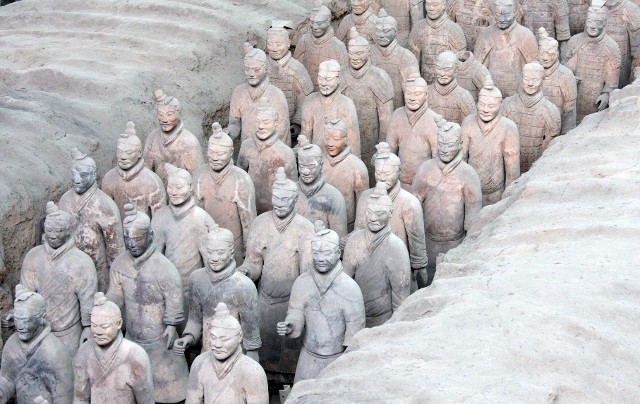
Xi'An's Terra Cotta Warriors in Pit #1


After our whirl-wind tour of the warriors, we jumped on the expressway and headed deep in to the Qinlings. Before we to started our trek in to Foping, we opted to visit Yang County to search for one of China’s rarest bird species, the highly endangered Crested Ibis. Until the late 1980’s, ornithologists thought the Crested Ibis was extinct, but when a search team visited this region of China and showed a group of farmers images of the bird, a farmer mentioned that he thought that he had seen some in his fields in nearby Yang County. Not quite believing the farmer, the researchers were surprised to learn that there were at least six or seven of the birds living in this region! These individuals represented the entire world population of the Crested Ibis! Now with serious protection efforts and captive breeding programs, the population exceeds 1000 birds and there seems to be a bright future for this spectacular ibis species! This is no doubt one of China’s brighter conservation success stories.

The rare and endangered Crested Ibis (Nipponia nippon) seen in Yang County.
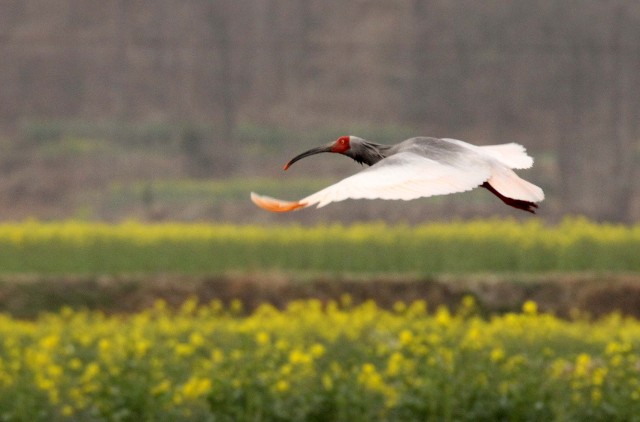
Crested Ibis (Nipponia nippon)
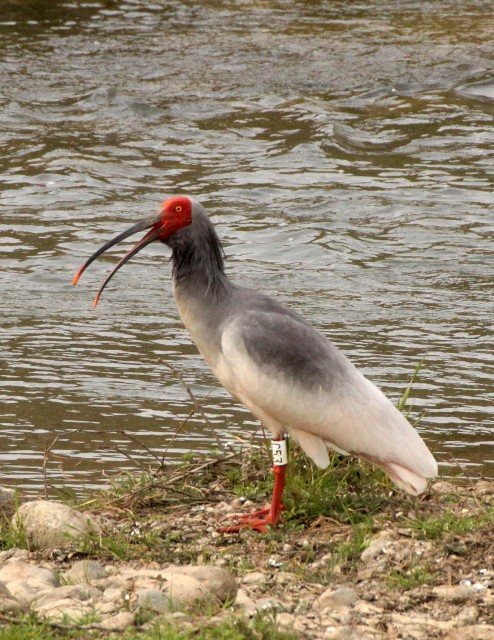
Crested Ibis (Nipponia nippon)
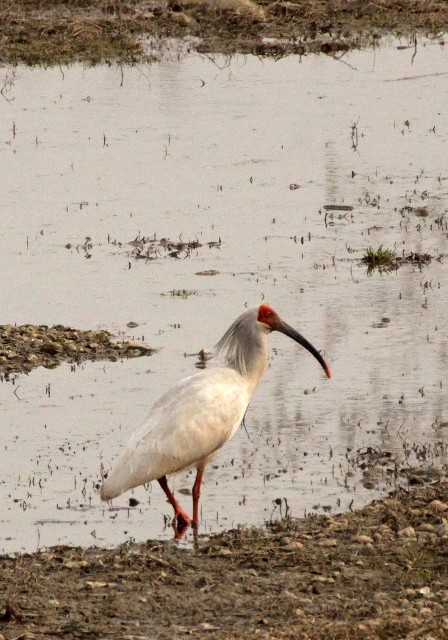
Crested Ibis (Nipponia nippon) in the nonbreeding plumage.
We did not take too much time to find our first ibises poking around the fields and streams of the reserve. In all, we came up with about 12-15 individuals in less than two hours! We were fortunate to see individuals in both the breeding and non-breeding plumages. We saw several other bird species in the area as well, such as a few lifers for me like the Crested Kingfisher, Water Pipit and Plumbeous Water Redstart.
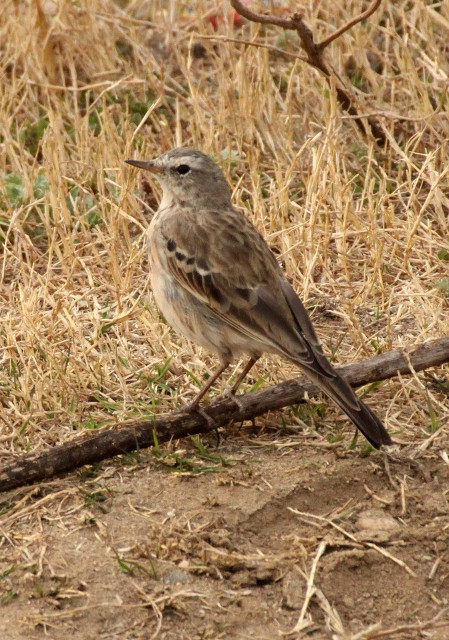
Water Pipit (Anthus spinoletta)
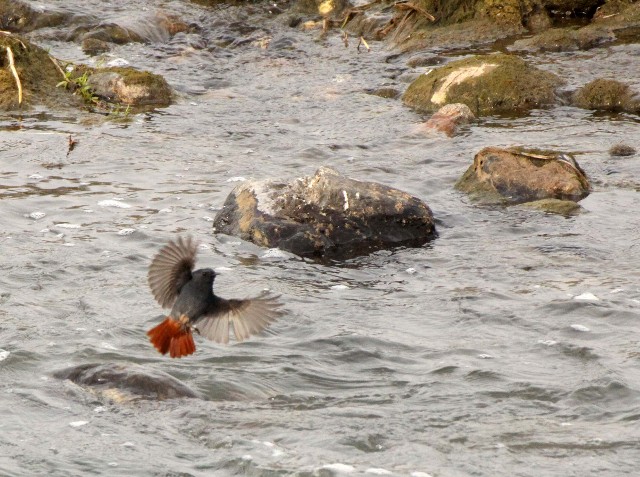
Plumbeous Water Redstart (Rhyacornis fuliginosus)
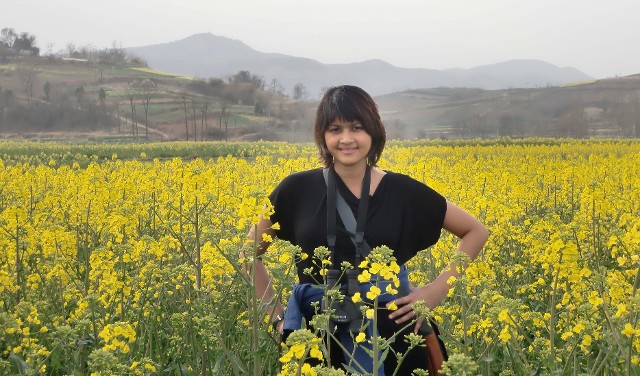
Som in the mustard fields of Yang County!
Our expedition got of to a great start with our first target being realized. Now we were off to Foping Nature Reserve for seven nights and six days trekking the mountains searching for the wild Giant Panda and the other species of the region! We were all very excited to say the least.
Along the way, Rolf knew a place where we may be able to spot another of China’s most spectacular bird species, the elusive Ibisbill. He knew of a bend in the river that he had spotted the species before, but I knew how this worked. There is never any guarantee that we would see it there again, so I did not get my hopes up too high. I had searched many other locations in China and India for this species with no luck so I was not holding out too much hope here either. But in less than five minutes, I spotted a spectacular Ibisbill poking around the cobble of the river searching for invertebrates. I was amazed with how camouflaged it was even though his plumage was very ornate and colorful. We spent several minutes watching this spectacular bird go about his daily activities before continuing our journey deeper in to the Qinlings.
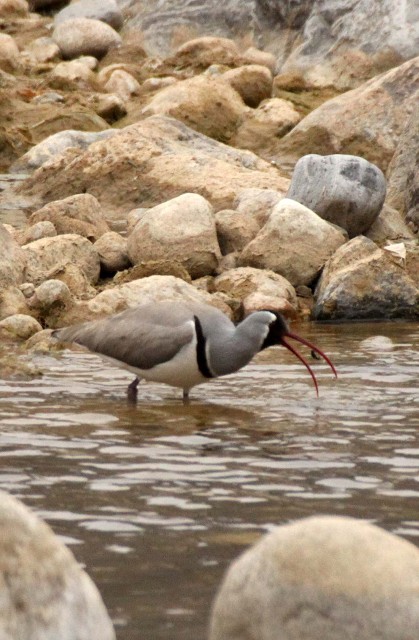
Ibisbill (Ibidorhyncha struthersii)
Our drive in to the heart of the Qinlings was winding and spectacular. The forests and topography of this great mountain range were superb. The northern Qinlings are home to a mixed conifer and hardwood forest adapted to a drier and warmer climate. As we approached the inner Qinlings, closer to Foping, I noticed a transition to a wetter, more lichen-covered conifer-dominated forest ecosystem. Not knowing the region’s plants well at all, I could not help but notice several familiar genera such as Cornus sp. (Chinese Dogwood), Betula spp. (various Birch species) as well as several Pinus sp (Pines) and several others.

The mixed conifer, hardwood forest of the Qinlings provides excellent habitat for an amazing array of species.

Comprised mainly of pines, fir and various broadleaved trees, this secondary forest was a pleasure to explore.
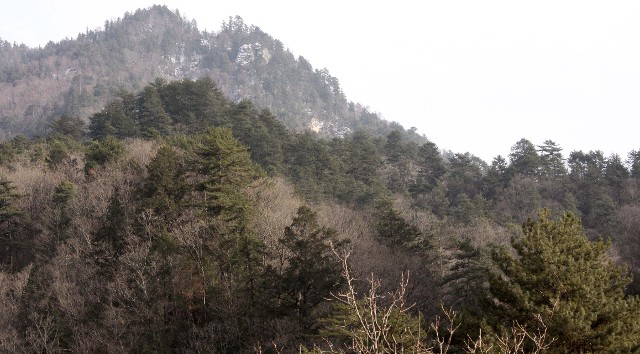
These were just some of the ridges we trekked and explored during our stay in Foping!
At lunch in Foping Town, Rolf got the first negative news of the trip. Evidently nature decided to change the climate considerably from a nice, spring-like day to serious winter! “Coke, I just found out it is snowing on top of the mountain”, Rolf gently informed me. Not quite knowing what his meant, I asked if this was a problem. “Yes, it could be a problem”, he said, in classic tour-guide understatement. I then decided we should scarf our lunch down and hit the road ASAP! He agreed and we proceeded to take on the last 45 km to the reserve. For the first 40 km or so we encountered a steady rain but so far no snow, but as soon as we started our ascent up the grade to the entry point of Foping NR, it began to snow increasingly hard. It would not have been so bad if the snow had just started, but it had been falling steady for over 24 hours and there was significant accumulation on the road.
It was not long before our bald-tired 2X2 van could no longer proceed up the very steep mountain road to the pass. We reached a steep grade about 8 km below the pass when we simply could not go any further. The location was remote and cold and we were basically going no further! Thankfully cell phone service is basically omnipresent in China so Rolf was able to procure some assistance from a station up the hill. While we were attempting to get the van a few meters further, the van, containing both Som and Cokie inside, decided to slide down the hill and into a ditch! All I remember hearing is Som screaming and turning to see the van slide down the road and off in to the ditch along the side of the road! I was mortified but at the same time extremely relieved – the direction the van decided to slide was in to a safe ditch. Had it gone the other direction, it could have very easily slid right off the road and in to the river far below the road! This was way too close for comfort.
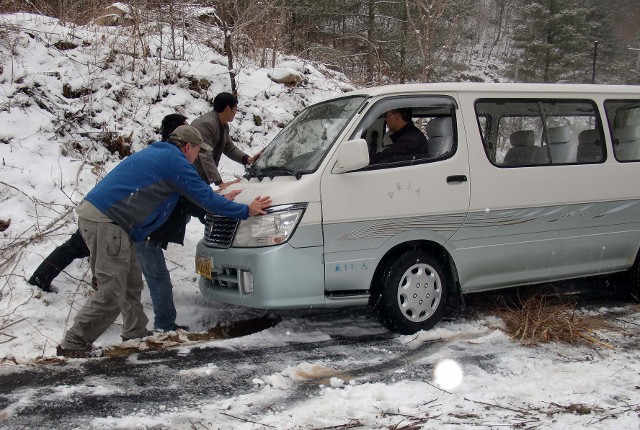
Thank goodness the van slid over to this side of the road. If it had slid down the hill, a river valley would have been where it ended up!!!

Don't underestimate a pile of twigs to provide solid substrate!
We were able to get the van unstuck with some creative pruning of the surrounding vegetation and maneuvering. Luckily we were able to free the van with little wasted time and eventually another car with chains came on the scene, beckoned by Rolf, to get us up to the top of the pass. By this point we were nearing white-out conditions and the snow storm was getting serious. As our little chained-tire car made easily up the steep grade to the top of the pass (2650m in elevation), we were thinking of the snow-bound existence we were in for during the coming days.
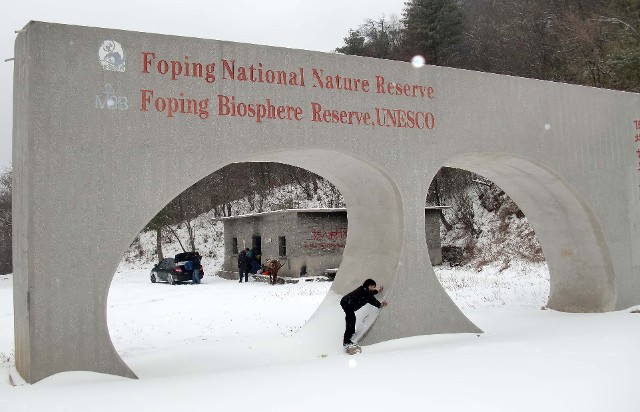
Finally up to the top of the Foping Reserve pass! Now all we had to do was trek 8km down to the field station.
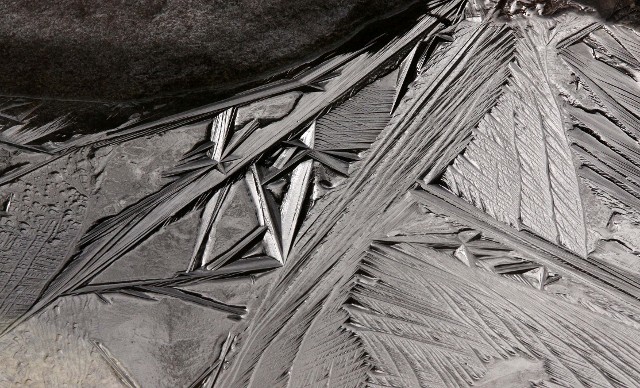
Although the scenery and landscapes were spectacular, the frigid temperatures made the expedition particularly challenging.
The next part of our journey involved an 8 km trek deeper still in to the Qinlings through the snow. Luckily the trail from the top of the pass was well manicured and the trek was relatively easy, albeit very slippery, cold and wet. A small pony was responsible for hauling all of our gear in to the base camp. I was initially concerned that this little horse would not be able to carry all of our gear but it handled it like an animal twice its size! I found out later that it was small horses like this one (and most likely including this one!) that enabled the construction of the entire field station in the heart of the Qinlings! It took over 2.5 years of 14 horses daily carrying loads of concrete and bricks up and down the trail to the pass – truly an impressive accomplishment!
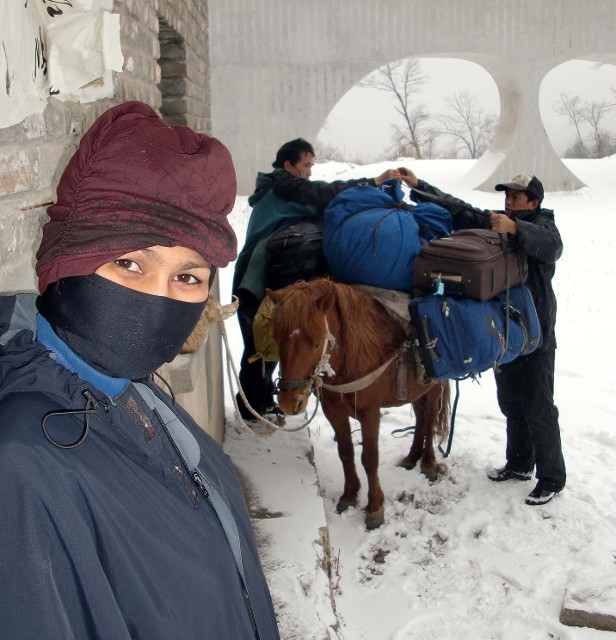
I could not believe this little pony could actually handle all that gear!
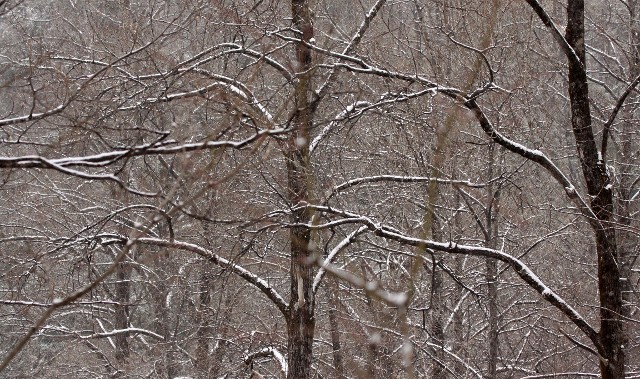
The forest was quiet and sublime during this unseasonable winter blast.
Our trek to the field station took us through a spectacular series of snow-bound valleys and forests. The thought of the snow potentially making our trip extremely difficult temporarily subsided with the thought of the sublime wilderness we were entering. Although the forest was clearly secondary in nature, it was in phenomenal condition and provided ample habitat for many species of fauna.
Within our first three hundred meters of trekking one of our trackers, Mr. Lee, pointed out several massive Takin tracks in the snow! Great sign! I was regaining hope that this would be a successful expedition after all. In fact, the snow allowed for us to see numerous tracks throughout our week in Qinlings.

Although I only saw two, sign of the Golden Takin was literally everywhere!
After a couple cold hours trekking to the field station, we finally made it to our home for the next seven nights. Our abode was a new building built earlier this last year mainly for the ecotour operation that had started in the region in 2004. Our room was a well-appointed, two bed arrangement. Although there was absolutely no heat or hot water, we were pleasantly surprised that the room was as nice as it was. We heard that future groups would be blessed with heat and hot water, but we were not so lucky this trip. It would not have been so bad if the temperature had warmed up at all. For the first five days of our expedition, the outside temperature barely exceeded two or three degrees and generally hovered around zero! We were bitterly cold for most of the trip. Luckily there was a “warm room” up at the main part of the station where we could hang out with our trackers and stay warm and cozy! Actually this was a good thing, as had it been warm in our room, we would have likely missed out on the many hours of good conversation with Rolf and our other trackers about China, Chinese wildlife and conservation and many other topics that week. I really enjoyed our talks.
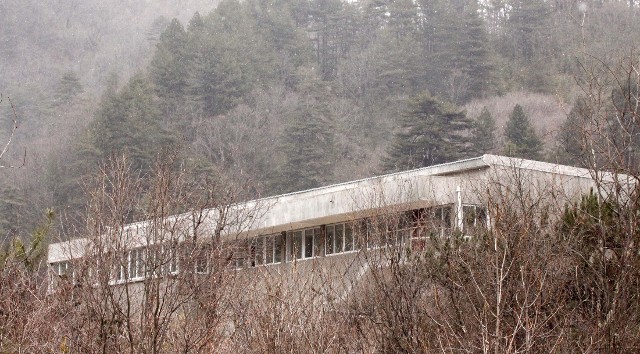
Basecamp Foping! This newly constructed building is especially for the ecotourists the reserve is hoping to attract. Currently about 100 tourist come every year making the grand total of tourists to ever see a wild panda less than 600 or so! We are in very privileged ranks to be sure!
Luckily our beds were blessed with electric blankets so once we were beneath the covers, we could warm up a bit. In fact we were able to sleep fairly well at the station. Although the living arrangements were fine, the food left a bit to be desired. That is, unless you love oil – lots of it! The dinners were tasty but drenched in oil. But we did not complain as we came to the dinner table famished every day and always killed it all off! Breakfasts were purely vegetarian and were very untasty. We are easy eaters but after seven breakfasts we were very happy to get the buffet breakfast feast once we were back in Xi’an! Lunches consisted of cookies and snacks. Our advice for any travelers thinking of traveling on this adventure is to stock up on any food items you can’t live without PRIOR to coming in to the station.
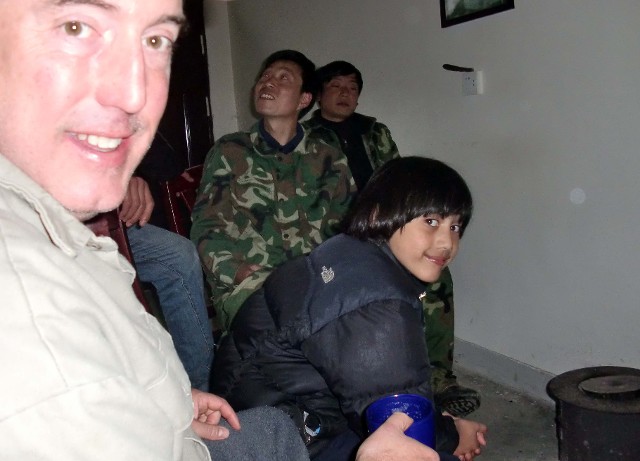
Hanging in the "warm room" with our buds!
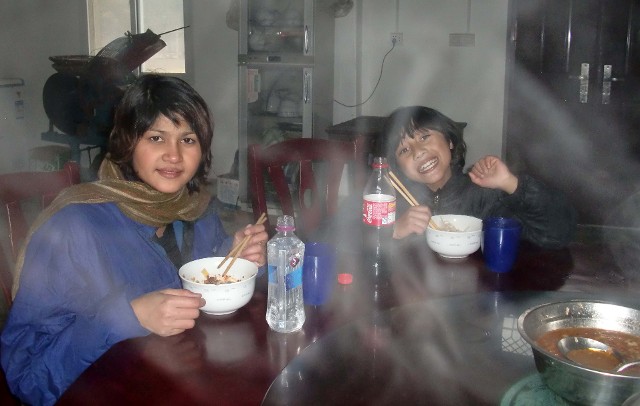
Cokie and Som enjoying a gourmet meal at the Foping Field Station cantina!
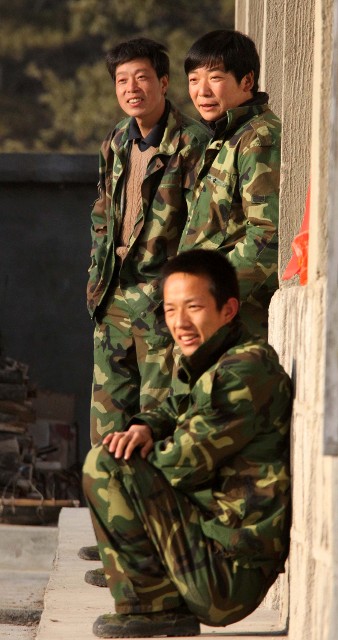
Rolf (seated), Mr He (left) and Mr. Zhang (right) enjoying some very rare sun exposure at the field station.
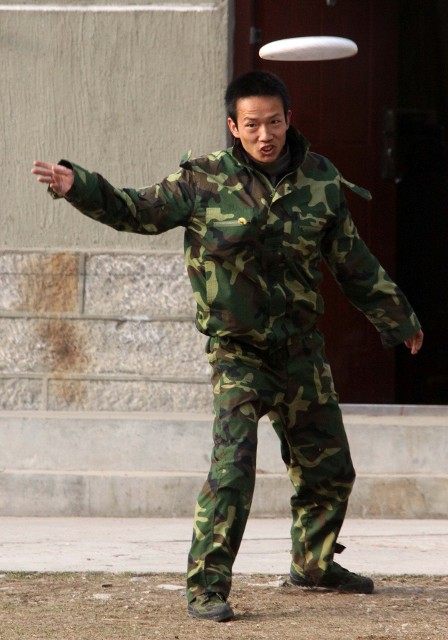
Rolf getting in to some frisbee at the station!
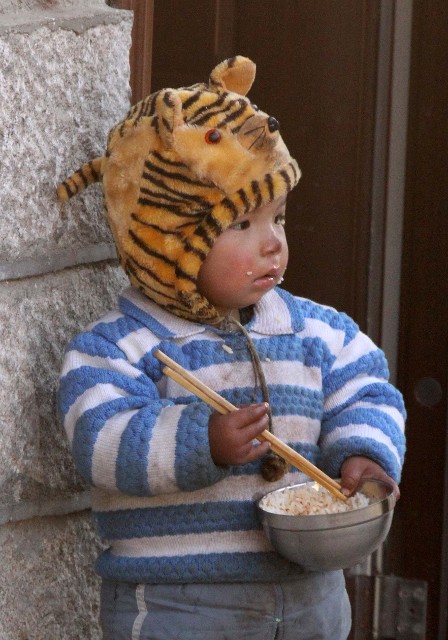
Little "Tong Tong" enjoying breakfast. This little guy was the camp mascot for sure!
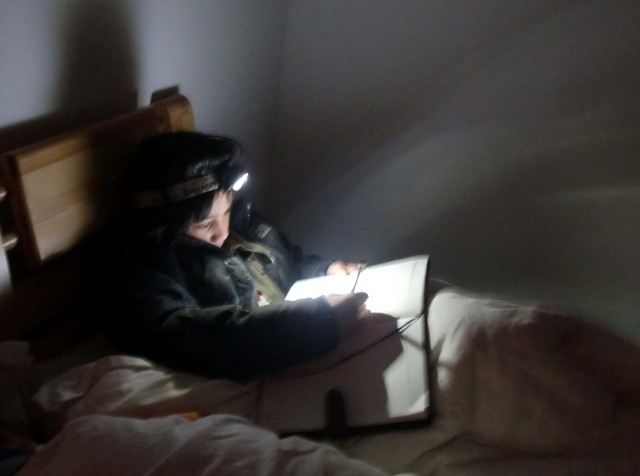
Cokie keeping his journal in our refrigerated room!
After our first official night in the reserve, it was now time to officially start our adventure in the Qinlings! By about 9AM we started the first of our daily treks in to the wilderness searching for wildlife. The treks generally had a fairly slow start – up the hill a bit to the point where we would wait for word from our three trackers as to if they came across any sign of a panda or other species of interest. Our first day was to prove to be extremely lucky! Within the first two hours of our morning, our trackers came across a wild Giant Panda just a few kilometers away from our position! It was exciting to try to listen to the chatter on the walky talkies. And we knew something good was happening when the normally noise talking turned in to deep whispers!
Rolf was very clear that once we received word from the trackers that they had a panda, we had to proceed very quickly and very quietly to their position if we hoped to get a glimpse of the critter! As basic as this sounds, this was one of the hardest parts of our entire expedition. Our pace through the mountains was extremely slow for many reasons: our condition was truly tested by the rigors of trekking the Qinlings; the terrain was absolutely treacherous – steep, extremely slippery, filled with impenetrably dense vegetation; the speed at which the agile and nimble trackers was nearly impossible to keep up with (except for my mountain goat son)!
Our first day’s chase of our panda was to prove to be one of the most difficult pursuits I have ever undertaken for any species. The chase involved over 8 kilometers of hiking up ridges, down ridges, in to valleys and up ridges again... And each of these topographies involved steep grades that could only be overcome on all fours or with help from others. Thank goodness for the well-rooted bamboo that saved our necks more than once. And once atop the ridges, we were walking a narrow apex that allowed for absolutely no error whatsoever, lest we were to fall down a slope for several hundred meters resulting in absolute serious injury or worse. We kept arriving at where the trackers were only to find that the panda had moved on. This happened four or five times before we started contemplate defeat.
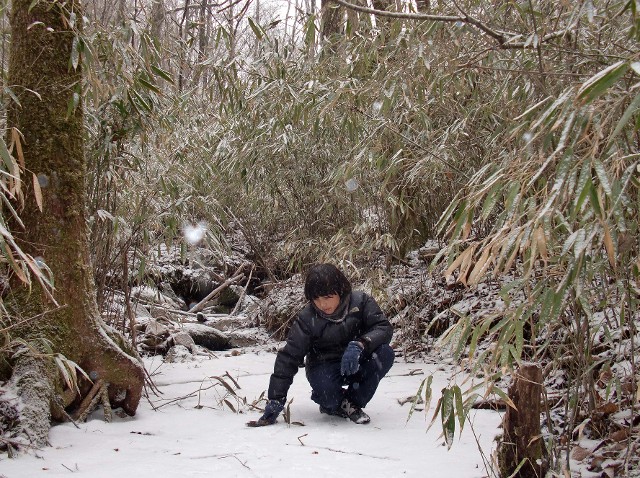
Cokie inspecting some fresh Giant Panda sign on our first day's adventure tracking a wild panda!
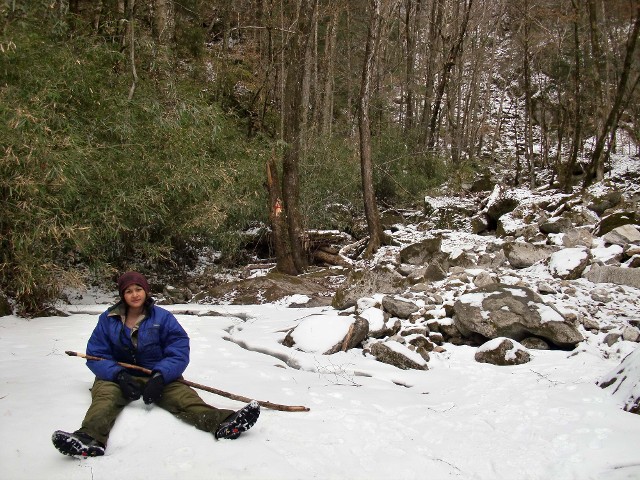
Exhausted Som taking a well deserved rest in an area riddled with sign of many different mammal species.
We were not to give up! Although we could not come close to keeping up with the trackers, they never gave up either. I could see that they were going to continue to pursue this panda until we got a look at it. And after about three hours of the chase, we finally got it! A huge boar Giant Panda came walking out of the bamboo thicket responding to the calls of our trackers and proceeded to walk down the slope directly in front of us! The trackers directed this amazing animal in our direction so that we could get a glimpse of it. And they did it with such skill and precision. We had about three minutes with this individual before it continued down the valley deeper in to the bamboo thicket.
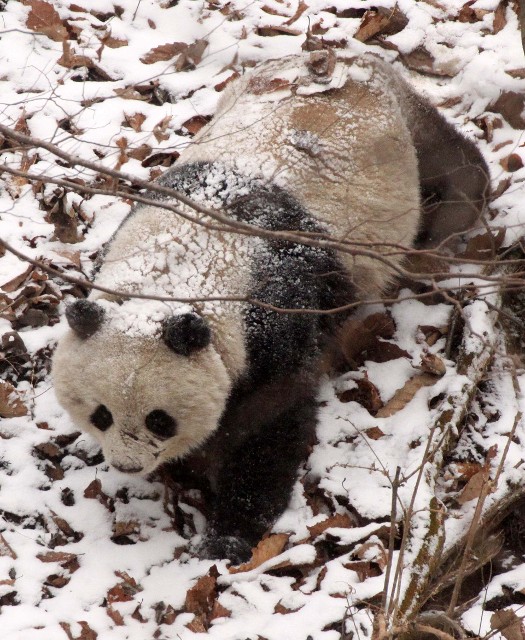
My first WILD Giant Panda! I will never forget the feeling of seeing this magnificent animal come up and around the ridge in our direction. He saw us for sure but did not seem to care at all.
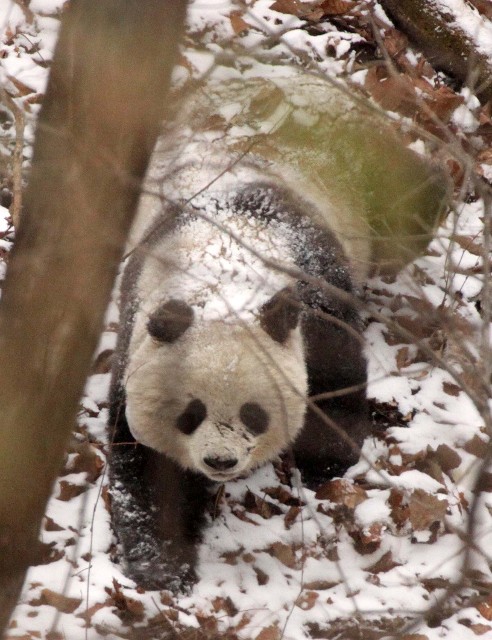
Our Giant Panda looking at us on top of our ridge just a few meters away!
I was exhausted but could hardly contain my excitement after having seen my very first wild Giant Panda on our first trek in to the Qinling wilderness! And it was a pretty good, albeit short, sighting. And even better was the fact that both my son and my wife were able to see this noble creature as well! Cokie was cold and wet but seeing him watch this panda travel his course down the mountain was in itself worth all of the pain and effort of this trek. We were later to learn that Cokie was and is by far the youngest tourist to ever see a panda in the wild, anywhere in China. This was official! Cokie really thinks we need to notify Guinness about this one!
After several moments of us congratulating ourselves for our good fortune, we decided to make the long hike back to the field station. But as we were heading down the hill, I just happened to glance across the valley to see our panda working its way back up the hill again! But this time, he was to give us a good half an hour view of his life! He sat directly across from us eating his bamboo and staring directly at us, not seeming to care at all about our presence in the slightest. I enjoyed spending this time with this panda more than virtually any wildlife experience I have had. I wonder what he thought of us.
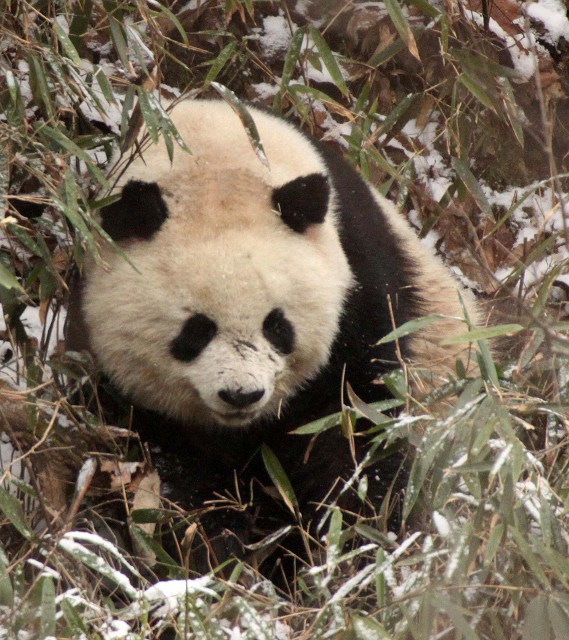
Our Giant Panda returned for a long bamboo feast which we observed for as long as our frozen bodies could take!
After watching our panda for as long as our frozen, wet bodies could handle, we decided to leave him to his bamboo and head back to base camp. The trek back proved to be as difficult as any. We traversed a creek valley for a couple kilometers that was filled with that damn impenetrable bamboo and even worse, endless downed trees that required me to crawl for hundreds of meters. This was far worse than climbing as it involved a nearly two-meter man to crouch to pass and enter very small openings in the thicket over and over again. This required me to use muscles I did not even know existed! The next day I was about as sore as I have ever been.
On the way down the hill we did come across a dead Golden Snub-nosed Monkey frozen in the snow. Although I was sad to see such a glorious primate so ingloriously dead in the snow, it ended up being the only sighting of this animal for the entire trip. We were not sure why the animal died as there was no outward sign of trauma. It was eerie who his teeth clenched the blades of grass they way it did, as if it were trying to have one last meal before he died.
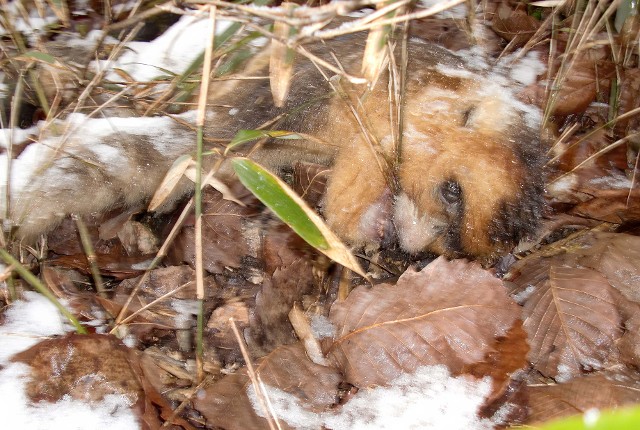
This poor Golden Snub-nosed Monkey was frozen in death and time with his last meal still clenched in his teeth.
Day two, Cokie and Som decided to rest a bit which was completely understandable. Rolf and I decided to trek to the village a few hundred meters below the field station. Aside from a few new species of birds, we were not to see any new mammal fauna there. This trek was far gentler than the preceding day’s. I decided to give Rolf and the guides the rest of the day off while I trekked the valley myself in search of whatever. Although Cokie and Som had decided to rest, the joined me and added about 8 km to the day with a trek up the gorge and in to the valley. We did come across several bird species and even a few tracks of mammals but not much else. That is, until I decided to venture off by myself to a nearby stream to see what was there.
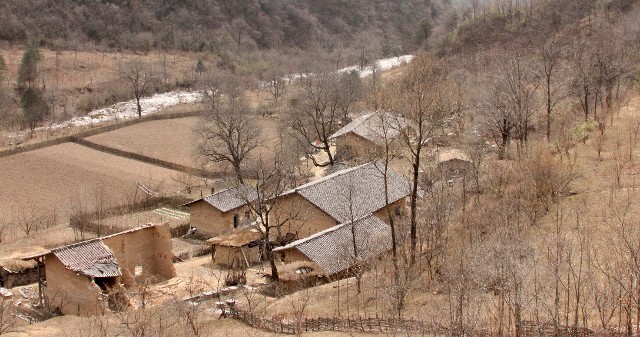
One of the few villages allowed to exist within the boundaries of Foping.
After glancing both directions up the stream and seeing nothing but a beautiful forest and creek, I heard a ferocious grunt coming from the bamboo thicket directly in front of me across the creek! This was followed by another and then a thundering sound of a very large animal rushing up the slope through the bamboo! Even though the light was fading, I did get a solid glimpse of the critter in question – a giant bull Golden Takin grunting and crashing its way up the hill! Day two and I was able to finally get my second target species! Although it was not the best sighting ever, it did count…. After seeing and feeling the immense size of this beast, I was very happy that there was a rushing creek between me and it…About the same time I was having this experience, Cokie and Som were on their own walk and they similarly surprised an unsuspecting Reeve's Muntjac! I was to be denied a sighting of this little cervid until the last morning when a couple camp dogs slaughtered one that was barking right outside my window all morning. Quite a mess!
Our third day trekking was to prove to be yet another treacherous and rigorous romp through the Qinlings. The only difference was that this time we were heading for Golden Takin & Golden Snub-nosed Monkey-country – meaning, straight up! After a couple kilometers of gradual incline, we started our steep ascent up one mountain after another! After about three hours of climbing endless ridges, I began to get very nervous about having my 8-year old son along on this increasingly dangerous trek. Our elevation was definitely exceeding 2600 meters and we were starting to reach some of the tallest peaks of the nearby ridges. In all of our climbing, I failed to notice just how high we had come and how many dangerously steep ridges were that we had climbed. The entire time, I was a nervous wreck watching my oblivious little son frolic his way up the hill, really not seeming to understand just how dangerous it was. After reaching a ridge at a time that seemed to be at a fairly late time of the afternoon, I decided to ask just how much further we had to go. Rolf advised that we had several more kilometers to go before we were to descend.
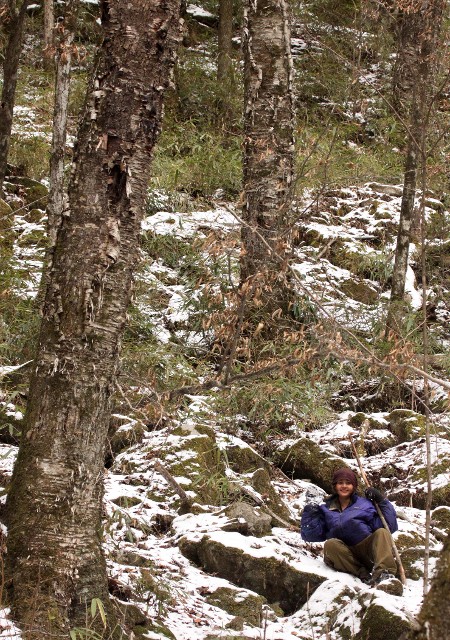
Som scooting down one of the many extremely treacherous hills we traversed this day!
At that time, I made an executive decision to call off the hike. It was just getting too dangerous for Cokie and Som, not to mention myself! Rolf understood the decision and suggested that we turn back right there. The only problem was that it involved going down the mountain! It was one thing going up the incredibly steep and slippery ridges but it was quite another going down! The grade was nearly vertical and if were not for the great stands of bamboo to grab on to, I am not sure how we would have made it down the slope. Of course Rolf and our trackers were like mountain goats (or better yet, Chinese Gorals!) and descended with great speed and agility, but Som and I were like clumsy elephants tumbling and slipping our way down the hill – it was actually pretty laughable. Cokie took up with the trackers and I could hear him laughing and giggling his way down the slope with ease. He thought this was the best fun of the trip! While I was in fear for everyone’s safety, he was having the time of his life…
In fact, Cokie was an absolute stud the entire trip. He was able to easily keep up with the trackers no matter the grade of difficulty level of the trek. The distances were no matter to him and he was easily able to go 10-15 km, no worries! The only problem he had was keeping the noise level down. The trackers really needed him quiet but this was something a bit too much for him so whenever they were approaching a wild animal, he was forced to hang back with the slow pokes, his parents. But this kid truly amazed me!
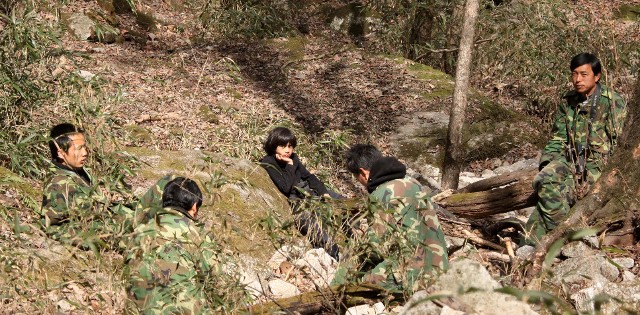
Cokie hangin' with his buds, our trackers! Cokie was able to keep up with these dudes every step of the way.
The hike back was a bit frustrating in that the trackers came across more than a couple mammals that we were to miss. They had seen a Chinese Serow and several Long-tailed Goral that we were not going to be lucky enough to glimpse. Oh well… One of the benefits of the snow was all of the tracks left for us to see. This hike in particular took us to a region of Foping that was a veritable superhighway of mammal traffic! On this trek, we came across fresh Long-tailed Goral, Chinese Serow, Forest Musk Deer, Golden Takin & Golden Snub-nosed Monkey sign, all of which were extremely fresh – some within minutes! One of the more fascinating series of tracks were those of several individual Dhole who all approached from different angles and greeted each other near a creek. We could see their approaches from many directions, and then we came upon a spot where they all came together and rolled around and played a bit before heading out again. Dhole are the only common sizable predator in the region evidently. Mr. He, one of our trackers, had recently seen an Asiatic Leopard hunt and kill a Wild Boar in one of the clearings near the main trail! But leopards are definitely rare. There are also rumors of Chinese Tigers in the mountains although there is no definitive evidence of their existence.
On one of our “warm-room” chats with Mr. He, we heard stories of his hunting days and when he was young. He recalled seeing homes filled with skins of many tigers and leopards and told us how they were all once very common in the mountains before hunting was banned. He told us that he even remembered seeing one particular leopard skin that was larger than even the largest tiger, hanging from the ceiling with his tail trailing on the floor! All of our trackers were retired hunters. Their hunting skills were exactly what made them such effective trackers for the ecotourists. I could sense that they missed those days a lot. We all enjoyed hearing his and the other trackers’ war stories about their time in the Qinling wilderness. They had some great stories.

The rare Temminck's Tragopan seen briefly on my solo trek up a remote valley in the Qinlings.
Our fourth day was yet another easy day. Cokie and Som had about enough searching in the mountains by this point and wanted some base-camp time to recoup. I used this time to venture off on my own in to the wilderness. I trekked about 15 km up the valley and in to several of the side canyons in search of whatever. Although I did see lots of new birds, including the elusive Temminck’s Tragopan, the “Giant Panda” of the birding world, I was unable to come up with any new mammals sadly. I did find it therapeutic and relaxing to be in this sublime wilderness alone for so many hours though. This was a good day. On the way back, I learned that Cokie and Som had embarked on the trail to meet me, but even though I retraced my steps for another 5km, I did not meet up with them. We had a good laugh back at base camp where I found Cokie of course playing with the great city he had built in the sand.
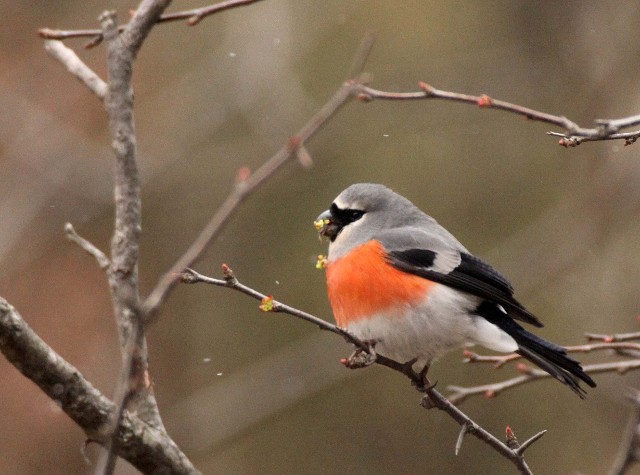
Grey-headed Bullfinches were one of the more common birds seen in Foping.

Eurasian Treecreepers were seen in only a couple valleys.
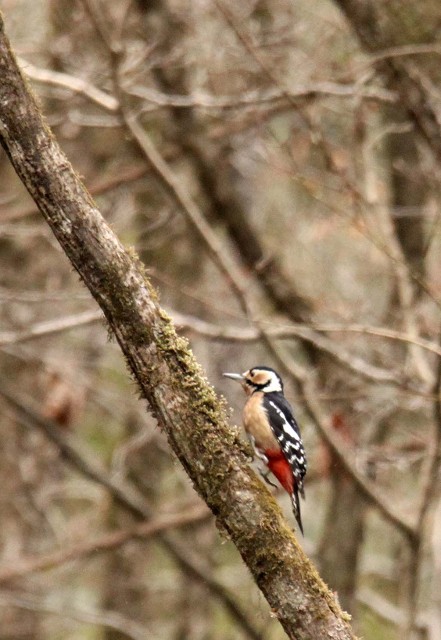
Great Spotted Woodpeckers were another common bird in the forest of Foping.
Our next day was one of great waiting! Although our trackers searched the Qinlings for over 30km, they never came across a panda or anything else for that matter. We spent the majority of this extremely cold day huddled around a fire along the main trail waiting for the whispers on the walky-talkies saying they had come across a bear. No luck today. But rather than simply giving up, I convinced everyone to continue the trek up a side valley that I had explored the day before. I had a very strong sense that there was something in that valley that was waiting for us to see it! After a couple km, Som and Cokie decided to head back, so Rolf and I continued up the valley a bit further. Seeing virtually nothing, we decided to head back ourselves. Along the route back, I spotted what looked like a giant golden rock on the ridge of the adjacent mountain. I told Rolf that I had a Golden Takin in my sights, but even he thought it was a golden rock. But then it moved! Finally I had a solid sighting a giant bull Golden Takin! We watched it graze the bamboo for several minutes before it slowly ambled over to the other side of the ridge. Rolf and I attempted to track if for a bit but eventually figured out that it had most likely seen us and boogied. But we got it! Too bad the pictures weren’t better though…
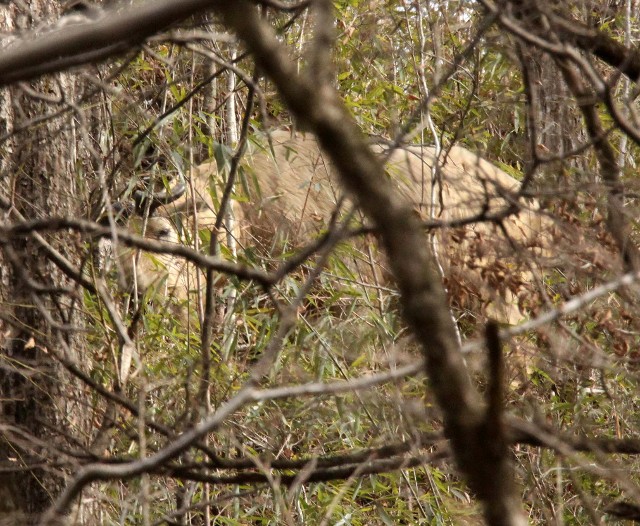
Although this is a very poor image, we did get a great viewing of this Golden Takin up the ridge from where we were standing.
Our final day in the Qinlings was to prove to be Cokie and Som’s favorite day on the trip. The weather had finally started to warm a bit and the sun was making a sustained appearance. We were to travel a few kilometers up a nearby canyon to search for the Red & White Giant Flying Squirrel. After we finally made it up the steep canyon, we came across several old trees with beautiful holes that were perfect for flying squirrels! The trackers found some bamboo poles to use to thump the trees (a technique used throughout China to coax the squirrels out of their dens – a technique that is not without its costs: after repeated thumpings, the squirrels tend to leave to find new homes further from people…). No sooner did Mr. Lee knock on the tree a couple times, did a massive Red & White Giant Flying Squirrel come gliding out of the hole to sail a couple hundred meters down to another tree! Cokie and Som thought this was the most amazing thing they had ever seen. Cokie even exclaimed that this was “even cooler than the panda!” I quickly “corrected”” his erroneous thinking… ;-)
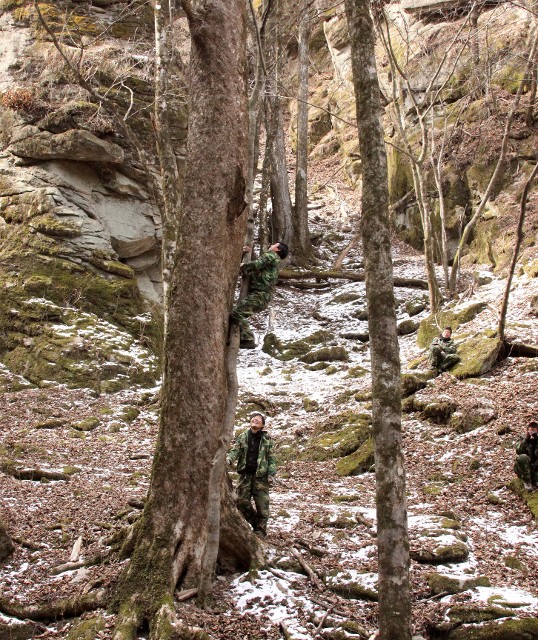
Our trackers waking the flying squirrel up...
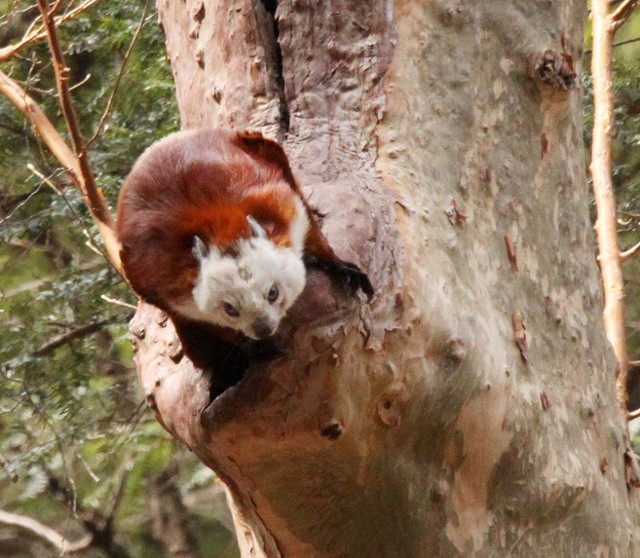
A spectacular Red & White Giant Flying Squirrel preparing for a glide down a valley at Foping.

Take off!
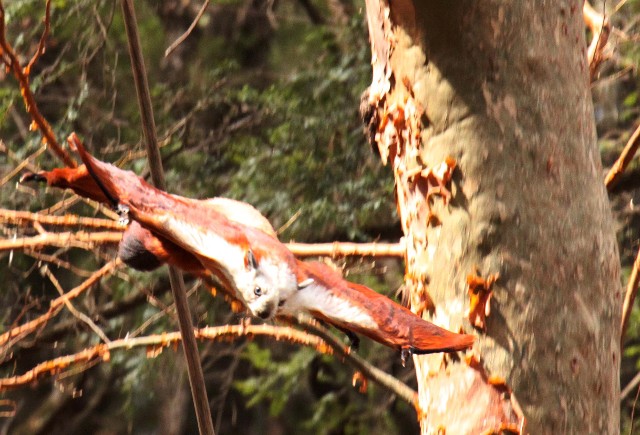
I was amazed at how close this magnificent animal came directly over head.
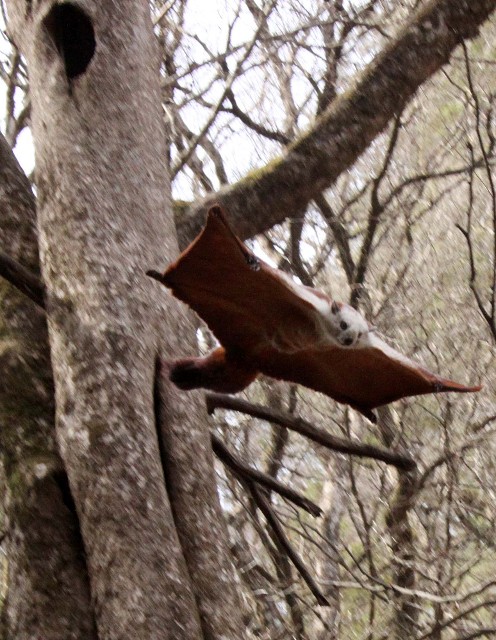
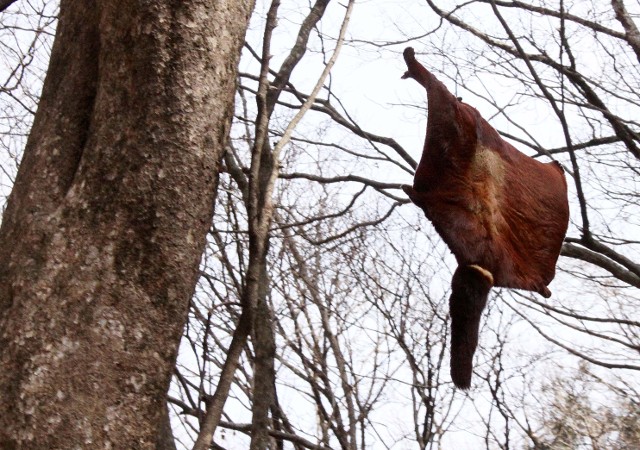
Red & White Giant Flying Squirrels are the largest flying squirrel species in the world.
After watching several squirrels do their aerial glide, we made it back down the valley. With the warm weather, we were treated to three new species in this steep canyon: Pere David’s Rock Squirrel, Siberian Chipmunks (possible Swinhoe’s Striped Squirrels), & Perny’s Long-nosed Squirrel. I then realized that on our last day, when the sun finally deemed it appropriate to show itself and raise the temperature above freezing, that the wilderness of the Qinlings was going to come to life! But a bit too late for the Smith clan!

Pere David's Rock Squirrels were commonly seen often at Foping.
On the last day of our adventure, Som and I walked the final 8 km trek up and out of the valley to the pass and our awaiting vehicle with the hope of nailing at least another species or two before we had to leave the amazing and spectacular Qinling Mountains. Although we were denied any other species, we both felt that the time in the Qinlings were very special and successful. We did get our Giant Panda and we had so many amazing experiences in the mountains. We talked about the day we called the hike on the ridges short due to the conditions. We spoke about how we would most likely remember this day more than any of the others with the extremes and danger and the beauty of the wilderness. We strained our eyes and our necks to try to get a glimpse of something scurrying around on the ridges or the trees. Nothing was to be seen, but we agreed that this was not the last time we would be in the Qinlings.
Wawu Shan & Ya’An , Sichuan
Only two days after returning home from the Qinling Mountains, I took off on another trip to Sichuan Province’s spectacular Wawu Shan and Ya’An Panda reserve to do some planning for an upcoming China Alive trip for SAS. Due to the temporal and geographic proximity of these trips, I have decided to enter a quick trip report here for Wawu Shan.

While the trip was mainly work, I was able to get in some wilderness time while exploring the trails and ridges of Wawu Shan Geopark in central northern Sichuan Province.
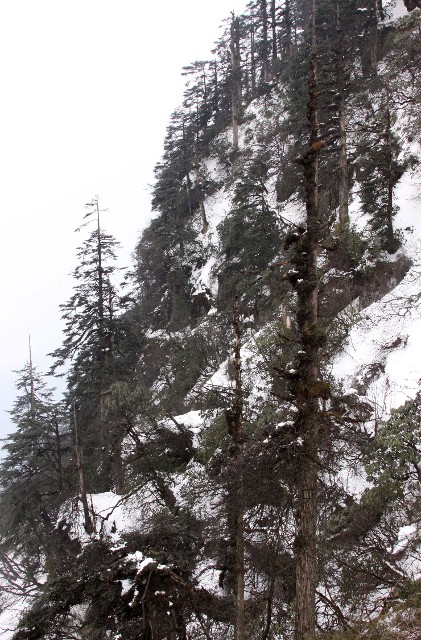
Wawu Shan is home to a splended Emei Fir forest at about 2800m in elevation.
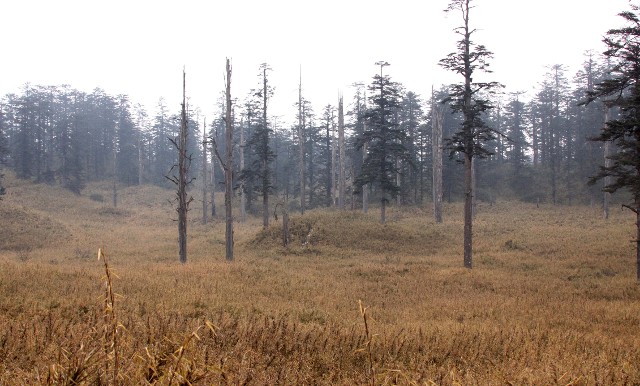
The so-called "Duck Pond" was where we saw very fresh sign of at least five Red Pandas!
Wawu Shan is a spectacular basaltic table mountain that is still covered with good forest, dominated mainly with Emei Fir forests. Home to over 40 species of Rhododendron species, the biodiversity of the area is absolutely impressive. And the mountain and surrounding areas are home to the highest densities of the elusive Red Panda. Although we never came across a good sighting of one, we did see very recent sign of at least five to six (or more!) individuals along the trails on the mountain. It was very exciting for myself, Zea (our SAS travel coordinator) and Steven (our school travel agent) to see such fresh sign in the snow. Although I would have loved to see the actual critter itself, I was still very satisfied seen such clear sign of so many individuals. And I was consoled a bit to know that I would be coming back again in May with a group of students to try yet again to spot one in the wild! Better luck then! We did come across a nice sighting of Lady Amherst’s Pheasant and a Temminck’s Tragopan however.

Fresh sign of a wild Red Panda!
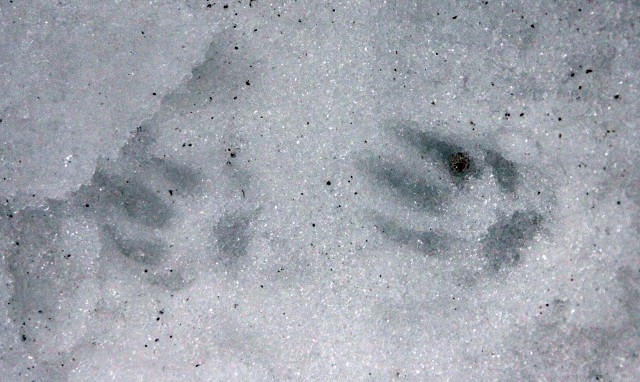
While in Sichuan , we also roamed the Ya’An Panda Reserve which is basically an outdoor reserve that is home to several dozen Giant Pandas for the purposes of breeding and recovery. Although these were definitely not wild in the sense that they were in their natural element, it was still very nice to see such beautiful pandas up close.
Giant Pandas at Ya'an Panda Reserve, Sichuan

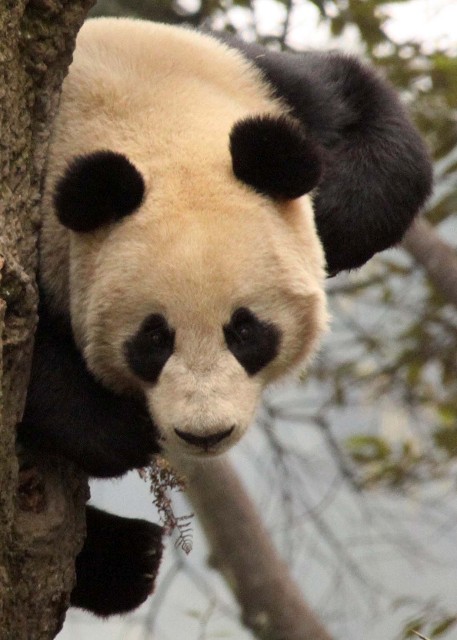
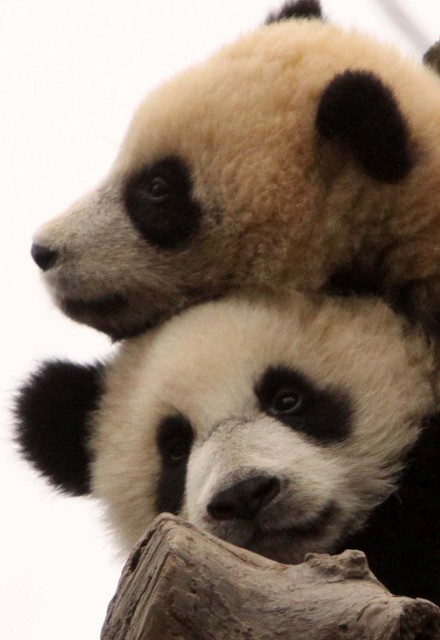
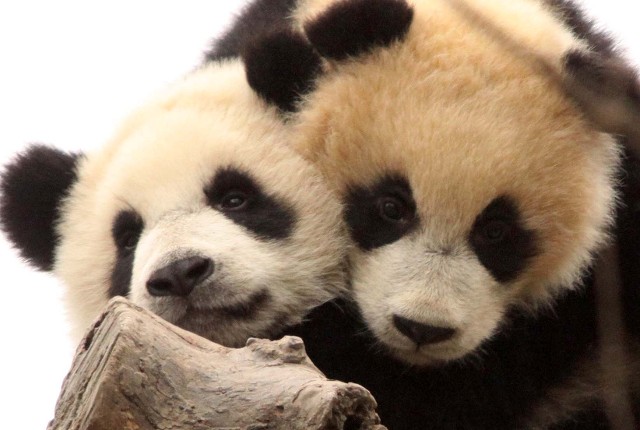
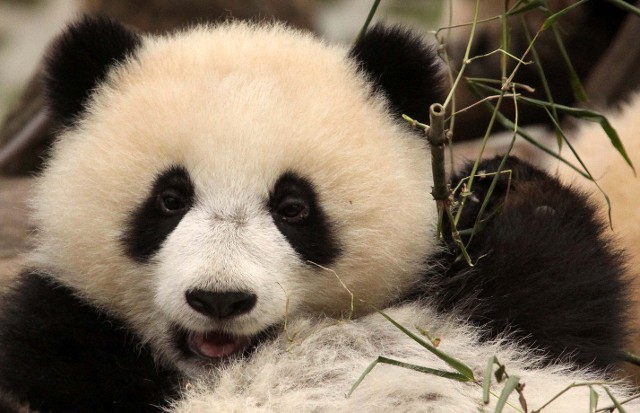
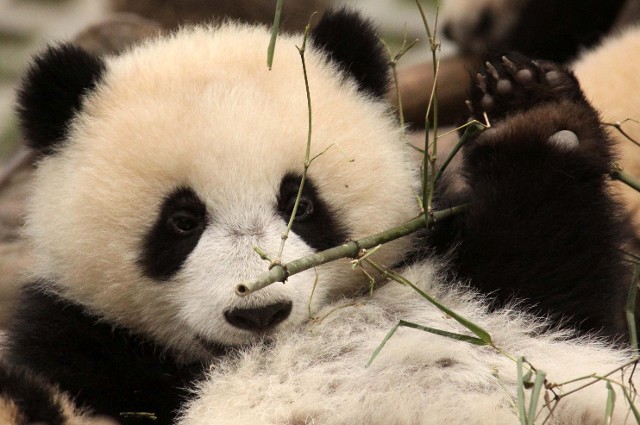



Giant Pandas at Ya'an Panda Reserve
Mammal List for the Qinlings
- Red & White Giant Flying Squirrel (Petaurista ablorufus)
- Perny’s Long-nosed Squirrel (Dremonys pernyi)
- Pere David’s Rock Squirrel (Sciurotamias davidianus)
- Swinhoe’s Striped Squirrel (Tamiops swinhoei)
- Siberian Chipmunk (Tamias sibiricus)
- Giant Panda (Ailuropoda melanoleuca)
- Reeve’s Muntjack (Muntiacus reevesi)
- Golden Takin (Budorcas taxicolor)
Fresh Sign & Near Misses
- Golden Snub-nosed Monkey (Rhinopithecus roxellana) – fresh tracks & recently dead male seen in forest
- Leopard Cat (Prionailurus bengalensis) – fresh scat seen daily on nearly all treks
- Dhole (Cuon alpinus) – fresh tracks on day three of several individuals
- Red Panda (Ailurus fulgens) – fresh tracks in snow of Wawu Shan of at least five individuals
- Yellow-throated Martin (Martes flavigula) – fresh scat
- Mountain Weasel (Mustela altaica) – fresh tracks on day two
- Wild Boar (Sus scrofa) – scads of fresh sign everywhere
- Forest Musk Deer (Moschus berezovskii) – fresh sign on two occasions
- Chinese Serow (Capricornis milneedwardsii) – fresh sign often and trackers seen at least two
- Long-tailed Goral (Naemorhedus caudatus) – fresh sign everywhere and trackers seen several. Cokie may have seen this too.
More Birds of the Qinlings!
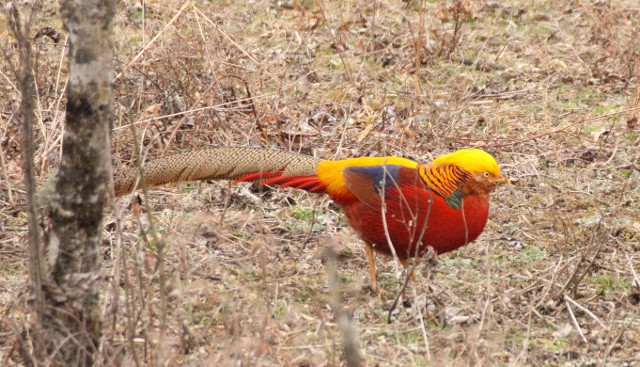
Golden Pheasants were extremely common due to the frigid weather.

Golden Pheasant!
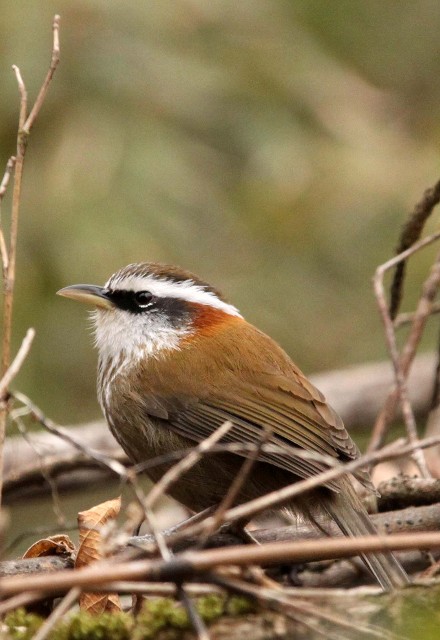
White-browed Scimitar Babblers are not found in China, according to my field guide! But guess what!

Red-billed Magpies are common and spectacular in the Qinlings!
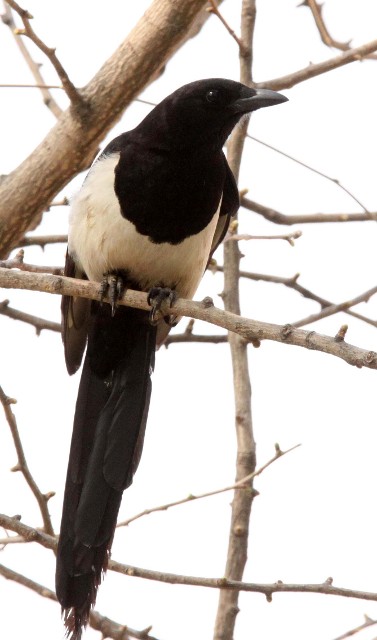
Black-billed Magpie
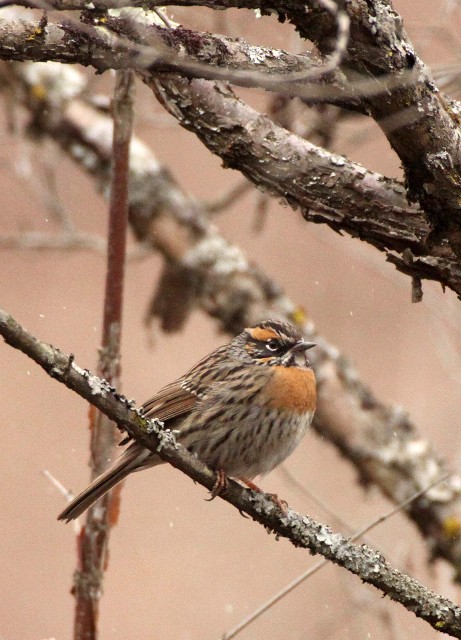
Rufous-breasted Accentor
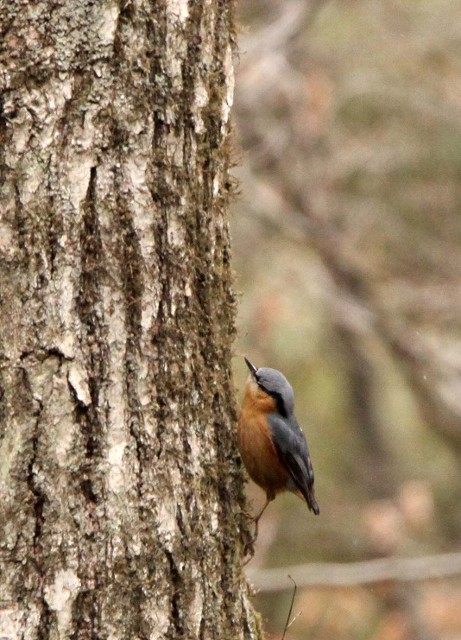
Chestnut-bellied Nuthatch

Spotted Nutcracker
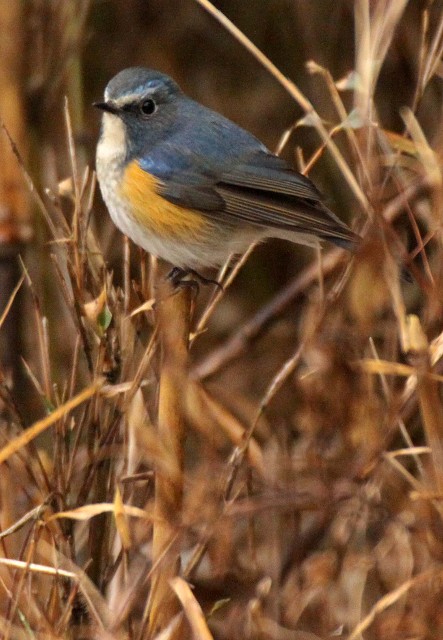
Orange-flanked Bush Robin
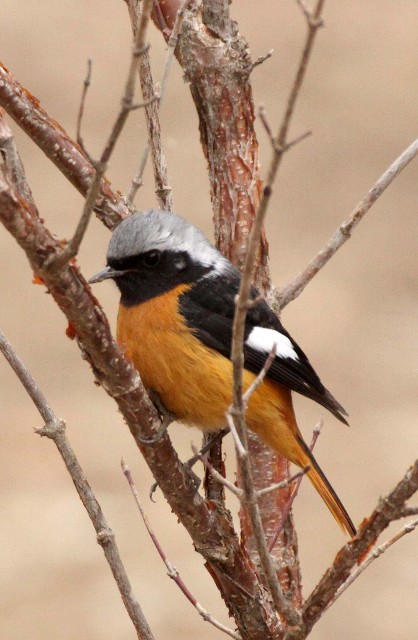
Daurian Redstart

Green-backed Tit
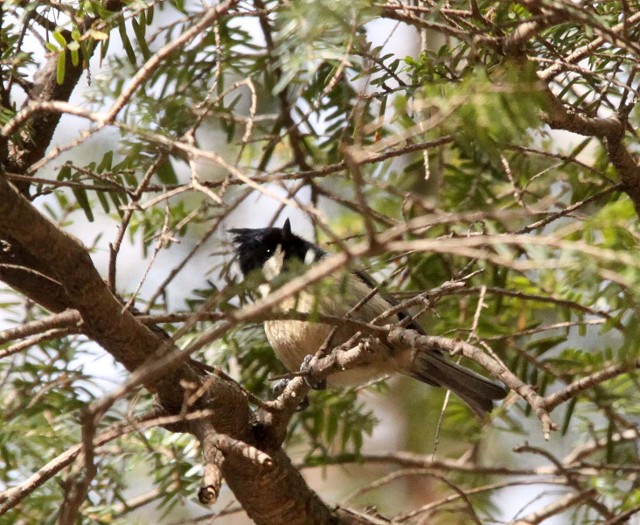
Coal Tit
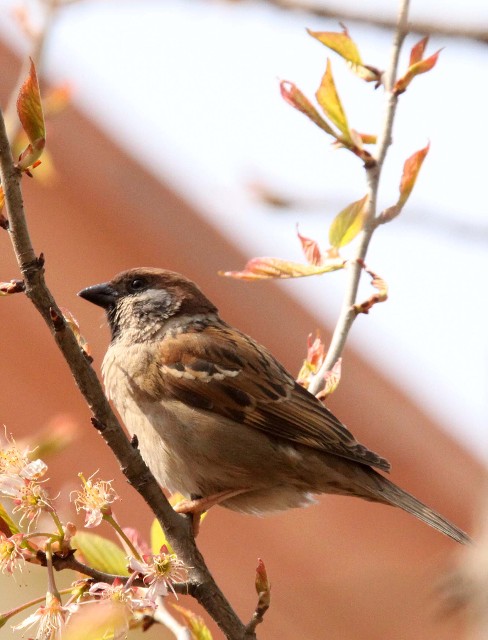
Eurasian Tree Sparrow
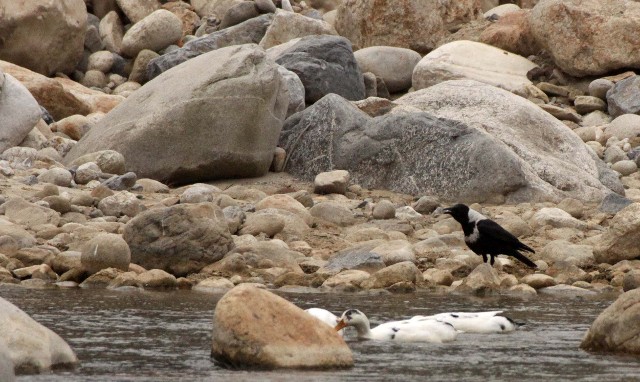
Collared Crow
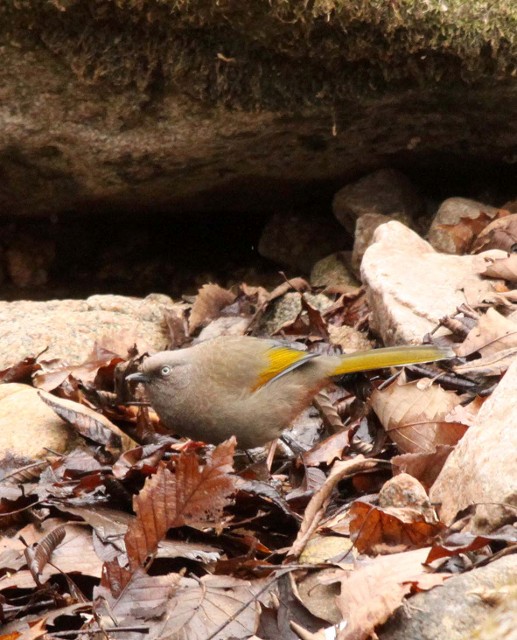
Elliott's Laughingthrush

Common Hoopoe

Steak-throated Fulvetta
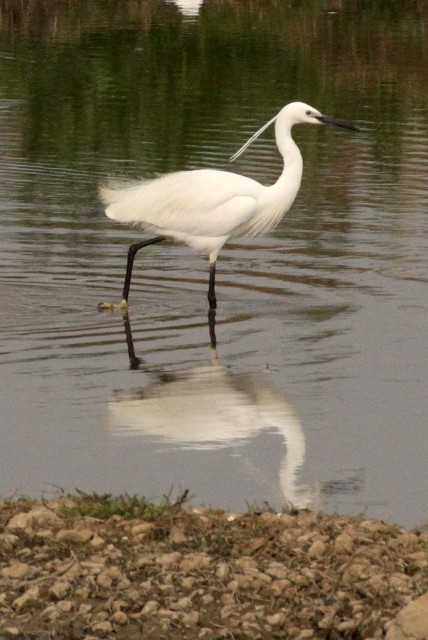
Little Egret
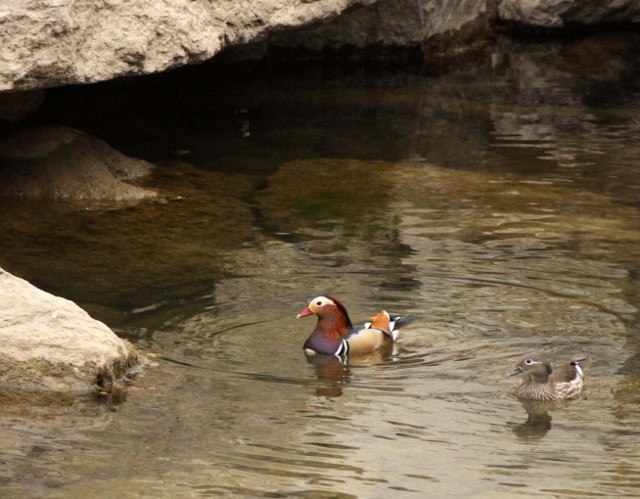
Mandarin Ducks!
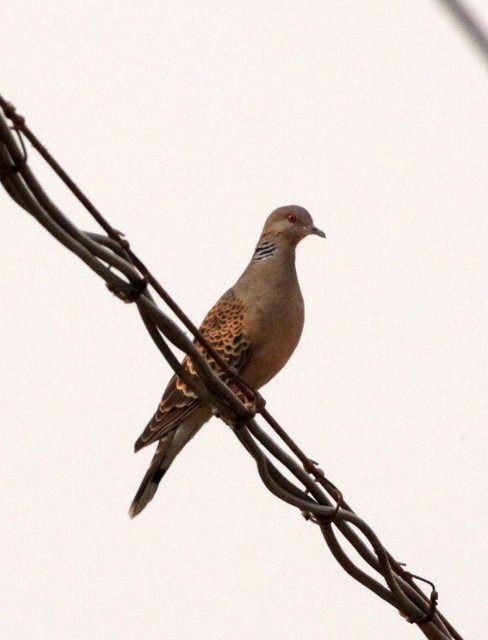
Eurasian Turtle Dove
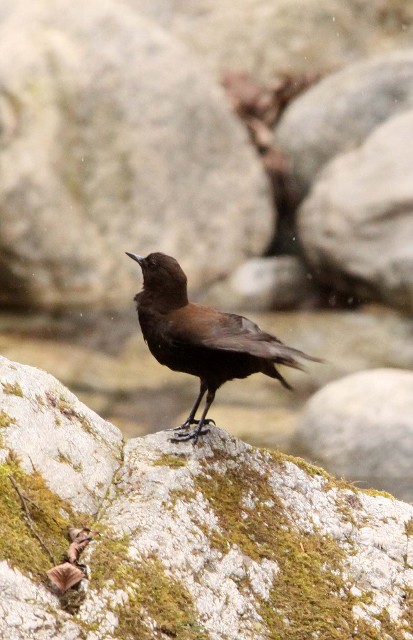
Brown Dipper
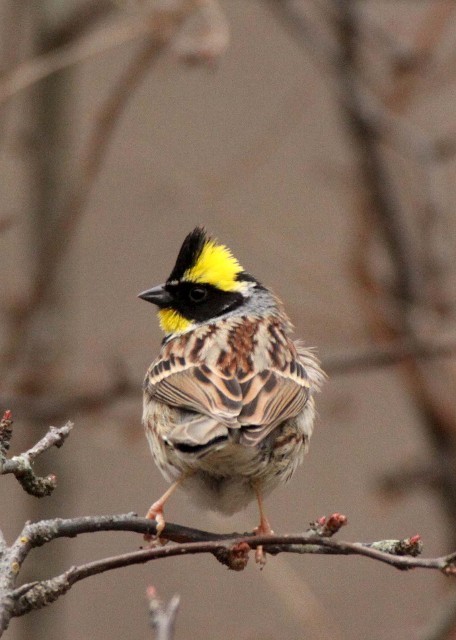
Yellow-throated Bunting
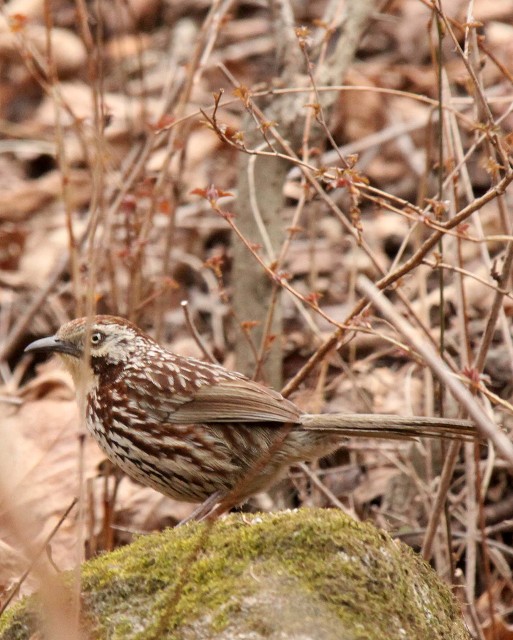
Chinese Babax
Bird List for the Qinlings
- Temminck’s Tragopan (Tragopan temminckii)**
- Lady Amherst’s Pheasant (Chrysolophus amherstiae)**
- Common Pheasant
- Golden Pheasant (Chrysolophus pictus)**
- Common Teal
- Madarin Duck (Aix galericulata)
- Great Spotted Woodpecker
- White-backed Woodpecker (Dendrocops leucotos)**
- Eurasian Treecreeper (Certhia familiaris)**
- Crested Kingfisher (Megaceryle lugubris)**
- Common Kingfisher
- Common Hoopoe
- Fork-tailed Swift (Apus pacificus)**
- Collared Scops Owl
- Eurasian Turtle Dove
- Common Snipe
- Green Sandpiper
- Grey-headed Lapwing
- Oriental Honey Buzzard
- Golden Eagle
- Little Egret
- Intermediate Egret
- Grey Heron
- Black-crowned Night Heron
- Crested Ibis (Nipponia nippon)**
- Ibisbill (Ibidorhyncha struthersii)**
- Long-tailed Shrike
- Red-billed Magpie
- Black-billed Magpie
- Spotted Nutcracker (Nucifraga caryocatactes)**
- Collared Crow (Corvus torquatus)**
- Large-billed Crow
- Scaly Thrush
- Rufous-breasted Bush Robin (Tarsiger hyperythrus)**
- Orange-flanked Bush Robin (Tarsiger cyanurus)**
- Daurian Redstart
- Plumbeous Water Redstart (Rhyacornis fuliginosus)**
- Little Forktail (Enicurus scouleri)**
- White-cheeked Starling
- Chestnut-bellied Nuthatch (Sitta castanea)**
- Coal Tit (Parus ater)**
- Great Tit
- Green-backed Tit
- Willow Tit (Parus montanus)**
- Brown-breasted Bulbul
- Elliot’s Laughingthrush
- White-browed Scimitar Babbler (Pomatorhinus schisticeps)**
- Rufous-capped Babbler (Stachyris ruficeps)**
- Winter Wren
- Red-tailed Minia (Minia ignotincta)**
- Chinese Babax (Babax lanceolatus)**
- Golden-breasted Fulvetta (Alcippe chrysotis)**
- Streak-throated Fulvetta (Alcippe cinereiceps)**
- Vinous-throated Parrotbill
- Eurasian Tree Sparrow
- White Wagtail
- Yellow Wagtail
- Olive-backed Pipit
- Water Pipit (Anthus spinoletta)**
- Grey-headed Bullfinch (Pyrrhula erythaca)**
- Yellow-throated Bunting (Emberiza elegans)**
- Rufous-breasted Accentor
- Brown Dipper (Cinclus pallasii)**
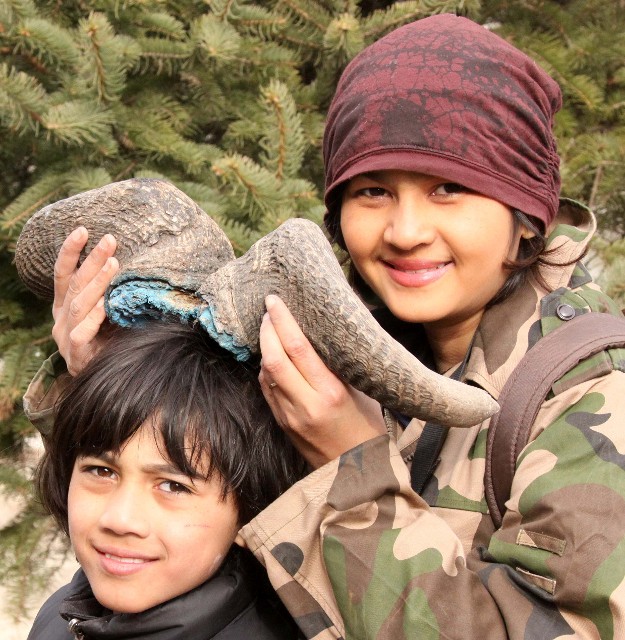
My little Golden Takin!
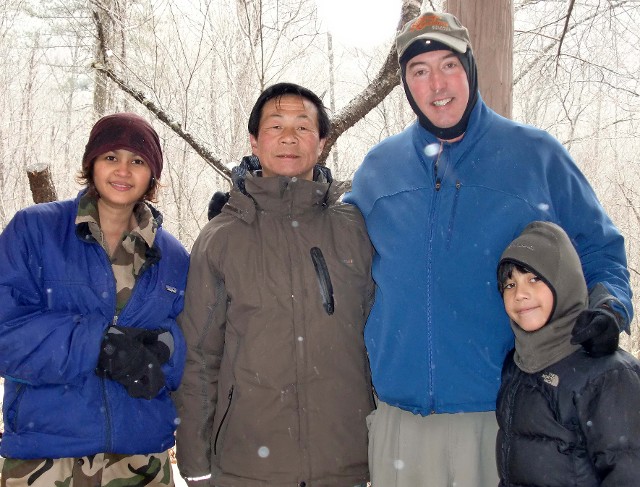
The famous Mr. Zhang of Nat Geo and Jon Hall fame!
Here are some more images of our expedition to Foping Nature Reserve:
Wild Giant Panda Images of Foping
Birds of Foping
Other Critters of Foping
Landscapes & People of Foping
Pandas of Ya'an Panda Reserve
